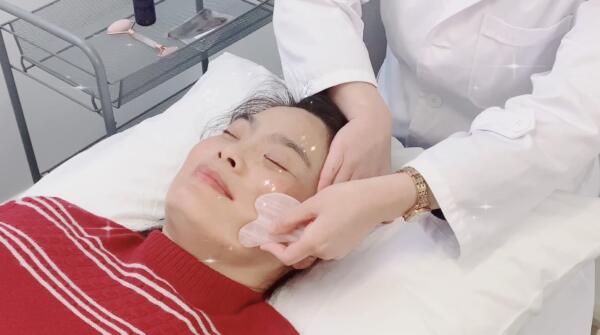Cosmetic acupuncture service in Geelong
Cosmetic acupuncture uses acupuncture points and techniques to address skin structural changes (acnes, fine lines and wrinkles) and internal factors that are related to those changes. It combines the Traditional Chinese Medicine (TCM) principles with scientific understanding of the skin. In TCM, it is believed that facial complexion and the skin ageing process are reflections of the internal disharmony, such as digestive intolerances, hormone changes and / or oxidative stress.
Facial acupuncture has a long history in TCM, and acupuncture points used for skin enhancement were first recorded in Zhen Jiu Jia Yi Jing (256-82 AD). It is widely held that the Chinese empresses used acupuncture for facial rejuvenation and anti-ageing since Song Dynasty (960-1279 AD) according to the published book Facial Enhancement Acupuncture: Clinical Use and Application, written by Adkins (2013).
In the modern days, cosmetic acupuncture has gained its popularity as a non-invasive anti-ageing alternative globally. It is known for its facial rejuvenation effects. Clinical studies have shown that cosmetic acupuncture treatments can improve facial elasticity (1), enhance the skin appearance and moisture level (2), soften the acne scarring, fine lines and wrinkles. They can also improve skin local skin microcirculation (3) and reduce Melasma areas (brown patches) (4).
During a cosmetic acupuncture treatment, a holistic skin care is offered. Individualised plans are provided according to Chinese medicine syndrome differentiation diagnosis. Acupuncturist will complete the regular full-body acupuncture first to address the imbalance in the body and ensure free flow of Qi (energy), then move to the facial part of the treatment.

Understanding cosmetic acupuncture

- Dryness and dullness of skin
- Acne and acne scarring
- Fine lines and wrinkles
- Uneven skin tone, hyperpigmentation
- Sagging and drooping
- In TCM, the hair and skin, including the complexion, are associated with the state of the internal organs. According to the Zang Fu theory, internal organs are each related to different aspects of the skin. For instance, the Lung in Chinese medicine governs the skin and plays an important role in controlling the pores. Dysfunction of the Lung (in Chinese medicine) has been linked to wrinkles and pigmented spots (5). Cosmetic acupuncture works by nourishing and re-balancing the Zang Fu function to achieve a glowing skin appearance.
- According to Yin and Yang theory, the foundation of Chinese medicine, a deficiency of Yin, a common phenomenon among people who has long-term history of alcohol use, who have frequent night shifts, or women during peri-menopausal stage, leads to skin dryness, cracking or wrinkles. Cosmetic acupuncture tonifies Yin, which hydrates the skin, improving the dryness and dullness.
Other mechanisms of cosmetic acupuncture can be explained as the following:
After high-quality and ultra-fine acupuncture needles (range from 40-70 needles) are inserted into the facial areas of concern, microtraumas occurs. The body then senses these micro-wounds, which trigger a localised micro-wound healing process, including (1-4)
- Stimulate the production of the collagen
- Restore resting mimetic muscle tone and improve facial elasticity
- Increase blood circulation and oxygenate the facial tissue
- Enhance water and oil content of facial skin
- Move blockages and stagnation
- Promote a bright and glowing complexion
In general, small percentage (1-2.9%) of patients who received acupuncture treatments reported a few mild adverse effects in a multicentre survey, including small bleeding, haematoma (bruising), dizziness, fatigue and local allergic reaction (rare) (6).
Rarely there are side effects associated with cosmetic acupuncture. However, a short-term, superficial bruising may occur occasionally when dealing with sensitive skin or patient is taking blood thinners. Appropriate care and advice during and after the treatment can prevent or manage bruising.
Cosmetic acupuncture involves the client in an organic, gradual process, which is customised for each individual. It is not a substitute for a surgical ‘face lift’ or Botox injection. To achieve satisfactory effects, repeated weekly acupuncture sessions are required for 10-12 sessions.
Each cosmetic acupuncture treatment usually lasts much longer than a standard acupuncture treatment session as it will address both internal imbalance as well as the skin issue. At Geelong Chinese Medicine Clinic, each cosmetic acupuncture cession will take 90 min and offers of a holistic skin care, including
- A comprehensive Chinese medicine consultation (15min) helps practitioners to assess your skin condition and make individualised plans according to Chinese medicine syndrome differentiation diagnosis.
- Body acupuncture: the acupuncturist will then complete the regular full-body acupuncture first to address the imbalance in the body and ensure free flow of Qi (energy);
- Facial acupuncture (30 min): After the body acupuncture, high-quality and ultra-fine needles will be inserted into the facial areas of concern. Electro-acupuncture may be used depending on individual conditions. In electro-acupuncture, small electrical current is applied to needles to strengthen the treatment effect.
- Jade facial massage (20 min): After all needles are gently and carefully removed, organic facial oil will be applied on the face followed by 20 min of Jade facial massage, using the natural quartz roller set.
- Finishing up.

Sources
- Yun Y, Kim S, Kim M, Kim K, Park JS, Choi I. Effect of facial cosmetic acupuncture on facial elasticity: an open-label, single-arm pilot study. Evid Based Complement Alternat Med. 2013;2013:424313.
- Donoyama N, Kojima A, Suoh S, Ohkoshi N. Cosmetic acupuncture to enhance facial skin appearance: a preliminary study. Acupunct Med. 2012;30(2):152-3.
- Gao Y, Lin W, Zhou S, Shi G, He J, Chen Y. Treatment of Rosacea using acupuncture for improving the local skin microcirculation: A case report. Medicine (Baltimore). 2018;97(34):e11931.
- Rerksuppaphol L, Charoenpong T, Rerksuppaphol S. Randomized clinical trial of facial acupuncture with or without body acupuncture for treatment of melasma. Complement Ther Clin Pract. 2016;22:1-7.
- Leung HYC, Leong PK, Chen J, Ko KM. Inter-Organ Relationships among Gut, Lung and Skin beyond the Pathogenesis of Allergies: Relevance to the Zang-Fu Theory in Chinese Medicine. Chinese Medicine. 2017;08(03):73-81.
- Ernst G, Strzyz H, Hagmeister H. Incidence of adverse effects during acupuncture therapy—a multicentre survey. Complementary Therapies in Medicine. 2003;11(2):93-7.
